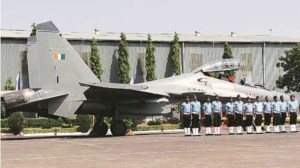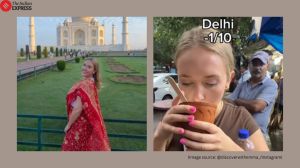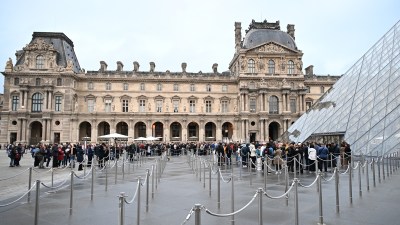Una flogging victims rebuild lives and assert rights — with a horse
Ramesh says he got inspired to buy the mare after an incident of 2018 in which a 21-year-old Dalit youth from a village in Bhavnagar district was killed for allegedly riding a horse.
 Balubhai Sarvaiya and his sons Ramesh (on the horse) and Vashram at their farm in Mota Samadhiyala village. (Express Photo)
Balubhai Sarvaiya and his sons Ramesh (on the horse) and Vashram at their farm in Mota Samadhiyala village. (Express Photo)He looks very different from the frail frame in those videos from Gujarat’s Una that shocked the nation six years ago. Ramesh Sarvaiya, 27, is now the proud owner of a beard — and a mare, Manaki (pearl), which he rents out for weddings. Both defiant symbols of assertion in the region against persecution of Dalits.
In July 2016, Ramesh, his brother Vashram (29) and their cousins Bechar (32) and Ashok (18) were publicly stripped, tied to a four-wheeler and flogged by a group of self-styled “gau rakshaks” for allegedly skinning the carcass of a cow. Since then, the Sarvaiyas have given up skinning animal carcasses, taken to Buddhism, and are making a living out of farming and Manaki.
Ramesh says he got inspired to buy the mare after an incident of 2018 in which a 21-year-old Dalit youth from a village in Bhavnagar district was killed for allegedly riding a horse. “I thought if people from other castes can keep or ride a horse or mare, why can’t the Dalits?” he asks.
The mare was bought from Palitana in Bhavnagar district for Rs 20,000, he says. “We got it trained for dancing in marriage processions by a trainer for one month. It cost us Rs 15,000. Then, we started renting it out to marriage parties.”
Ramesh, who handles the mare, and Vashram also began to sport beards and moustaches. “Because every now and then, we keep getting news about non-Dalits targeting Dalits for growing a moustache or beard,” says Vashram.
According to their father Balubhai (57), people from all communities in the area take the mare on rent. “But the maximum are from our Dalit community. We give them special discounts. Generally, we charge anything between Rs 8,000-10,000 per marriage party. But if a Dalit family is taking the mare on rent, we charge around
Rs 3,000-4,000. More than money, the mare is for our community’s pride,” he says.
Says Vashram, “Now, many people from our community come to us to get a photo clicked with the mare. Also, many Dalits in the region have started to keep a horse or a mare after we bought Manaki.”
But this symbol of assertion did invite unwelcome attention.
“One man from a higher caste, who comes from a neighbouring village to deliver milk, once tried to threaten Ramesh, saying Dalits cannot keep a horse. I countered him and he eventually sought an apology… I have become aware of our rights and learnt to speak for our rights,” says Balubhai.
Buying the mare is not the only change for the Sarvaiyas since 2016. The family has now given up their traditional profession of scavenging and skinning dead animals. “After that incident, we decided to give it up. If we are treated like this for our work, which is to rid society from the filth of a dead animal, we thought it is better not to do it,” says Balubhai.
In 2019, the family embraced Buddhism. Today, the walls of their porch are dotted with pictures of Lord Budhha, Jyotiba Phule, Savitri Phule and Dr B R Ambedkar.
Besides, Ramesh has undergone training in tailoring at the Dalit Shakti Kendra in Ahmedabad district, which is run by Navsarjan Trust, a Dalit rights group headed by activist Martin Macwan. And, Vashram is working for the Human Development Research Centre, an Ahmedabad-based voluntary organisation. “I take the initiative in any incident related to Dalit atrocity in the region, apart from other issues related to human development,” says Vashram.
On July 11, 2016, a group of “gau rakshaks” allegedly attacked Ramesh, Vashram, Bechar and Ashok, accusing them of skinning the carcass of a cow near their home in Mota Samadhiyala village. The four were also accused of having slaughtered the animal even as they claimed the cow was killed by a lion. When Balubhai, his wife Kunvar and a relative intervened, they too were assaulted.
The assailants then allegedly kidnapped Vashram, Ramesh, Ashok and Bechar in a car, took them to Una town and flogged them publicly before abandoning them near the police station. After the videos triggered nationwide outrage, a case was registered and later investigated by CID (Crime).
A total of 43 accused from upper-caste and OBC communities, facing several charges including attempt to murder and under the SC/ST (Prevention of Atrocity) Act, were chargesheeted, including four policemen who were accused of fudging facts in the case. The trial is currently on before a special court, and all the accused are out on bail.
The sarpanch of Mota Samadhiyala, in Saurashtra region’s Gir-Somnath district, says the village has moved on. With a population of about 2,500 people, mainly Patidars and OBCs, and about 100 Dalits, the village sarpanch claims they all “live in harmony”. “There are no issues between communities. In the 2016 incident, the accused were from other villages,” says Dadubhai Ahir, the sarpanch who hails from an OBC community.
The Sarvaiyas, too, insist that they have left behind the 2016 incident. But there are lingering reminders.
Vashram says his brother Ramesh was threatened once, in 2018, during an alleged bid to force the Sarvaiyas to reach a compromise in the case. “He (Ramesh) lodged an FIR against the two accused. Apart from that, there was no instance of anybody coercing us,” he says.
The family also says that apart from the statutory monetary compensation linked to the SC/ST Act, under which each of the victims “got Rs 3 lakh in compensation”, they have not got any relief from the state. “We were hoping to get some land or a house,” says Vashram.







